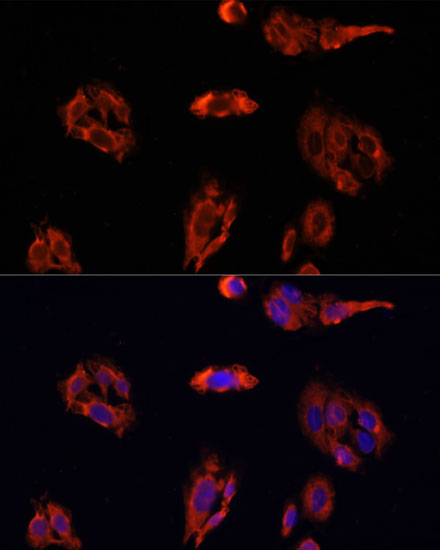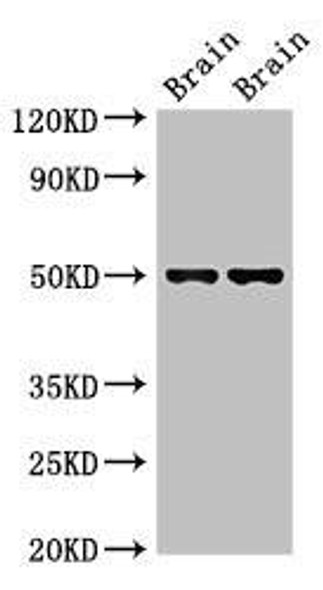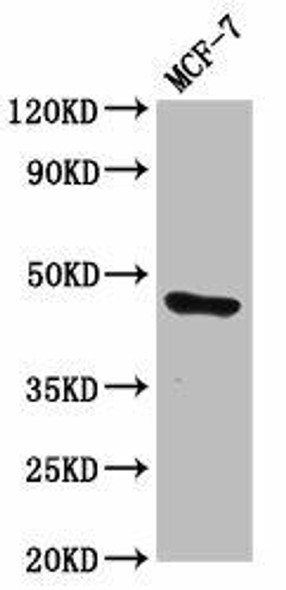Description
Anti-FAP Antibody (CAB6349)
The FAP Polyclonal Antibody (CAB6349) is a valuable tool for researchers studying fibroblast activation protein (FAP), a cell surface glycoprotein that is highly expressed in cancer-associated fibroblasts. This antibody, produced in rabbits, exhibits high reactivity with human samples and has been validated for use in various applications, including immunofluorescence and immunohistochemistry.FAP is known to play a key role in tumor progression and metastasis, making it a promising target for cancer therapy.
By specifically binding to FAP, this antibody enables the detection and analysis of FAP expression in different cell types, offering insights into its function in cancer biology. Researchers can use this antibody to investigate the potential of targeting FAP for therapeutic purposes in cancer treatment.Overall, the FAP Polyclonal Antibody is a reliable tool for investigating the role of FAP in cancer and advancing research towards developing innovative treatment strategies for cancer patients.
| Antibody Name: | Anti-FAP Antibody |
| Antibody SKU: | CAB6349 |
| Antibody Size: | 20uL, 50uL, 100uL |
| Application: | WB IF |
| Reactivity: | Human, Mouse |
| Host Species: | Rabbit |
| Immunogen: | Recombinant fusion protein containing a sequence corresponding to amino acids 26-280 of human FAP (NP_004451.2). |
| Application: | WB IF |
| Recommended Dilution: | WB 1:500 - 1:2000 IF 1:50 - 1:200 |
| Reactivity: | Human, Mouse |
| Positive Samples: | Mouse heart |
| Immunogen: | Recombinant fusion protein containing a sequence corresponding to amino acids 26-280 of human FAP (NP_004451.2). |
| Purification Method: | Affinity purification |
| Storage Buffer: | Store at -20'C. Avoid freeze / thaw cycles. Buffer: PBS with 0.02% sodium azide, 50% glycerol, pH7.3. |
| Isotype: | IgG |
| Sequence: | LRPS RVHN SEEN TMRA LTLK DILN GTFS YKTF FPNW ISGQ EYLH QSAD NNIV LYNI ETGQ SYTI LSNR TMKS VNAS NYGL SPDR QFVY LESD YSKL WRYS YTAT YYIY DLSN GEFV RGNE LPRP IQYL CWSP VGSK LAYV YQNN IYLK QRPG DPPF QITF NGRE NKIF NGIP DWVY EEEM LATK YALW WSPN GKFL AYAE FNDT DIPV IAYS YYGD EQYP RTIN IPYP KAGA KNPV VRIF IIDT TYPA YVGP QEV |
| Gene ID: | 2191 |
| Uniprot: | Q12884 |
| Cellular Location: | Cell membrane, Cell projection, Cell surface, Cytoplasm, Membrane, Secreted, Single-pass type II membrane protein, Single-pass type II membrane protein, invadopodium membrane, lamellipodium membrane, ruffle membrane |
| Calculated MW: | 26kDa/87kDa |
| Observed MW: | 88kDa |
| Synonyms: | FAP, DPPIV, FAPA, FAPalpha, SIMP |
| Background: | The protein encoded by this gene is a homodimeric integral membrane gelatinase belonging to the serine protease family. It is selectively expressed in reactive stromal fibroblasts of epithelial cancers, granulation tissue of healing wounds, and malignant cells of bone and soft tissue sarcomas. This protein is thought to be involved in the control of fibroblast growth or epithelial-mesenchymal interactions during development, tissue repair, and epithelial carcinogenesis. Alternatively spliced transcript variants encoding different isoforms have been found for this gene. |
| UniProt Protein Function: | FAP: In association with DPP4 is involved in the pericellular proteolysis of the extracellular matrix (ECM), the migration and invasion of endothelial cells into the ECM. May have a role in tissue remodeling during development and wound healing, and may contribute to invasiveness in malignant cancers. Belongs to the peptidase S9B family. 2 isoforms of the human protein are produced by alternative splicing. |
| UniProt Protein Details: | Protein type:EC 3.4.14.5; Protease; EC 3.4.21.26; Membrane protein, integral Chromosomal Location of Human Ortholog: 2q23 Cellular Component: apical part of cell; cell surface; cytoplasm; extracellular space; focal adhesion; integral to membrane; lamellipodium; plasma membrane Molecular Function:dipeptidyl-peptidase activity; endopeptidase activity; integrin binding; metalloendopeptidase activity; peptidase activity; protease binding; protein binding; protein dimerization activity; protein homodimerization activity; serine-type endopeptidase activity; serine-type peptidase activity Biological Process: angiogenesis; cell adhesion; endothelial cell migration; proteolysis; proteolysis involved in cellular protein catabolic process; regulation of fibrinolysis |
| NCBI Summary: | The protein encoded by this gene is a homodimeric integral membrane gelatinase belonging to the serine protease family. It is selectively expressed in reactive stromal fibroblasts of epithelial cancers, granulation tissue of healing wounds, and malignant cells of bone and soft tissue sarcomas. This protein is thought to be involved in the control of fibroblast growth or epithelial-mesenchymal interactions during development, tissue repair, and epithelial carcinogenesis. Alternatively spliced transcript variants encoding different isoforms have been found for this gene. [provided by RefSeq, Apr 2014] |
| UniProt Code: | Q12884 |
| NCBI GenInfo Identifier: | 292495099 |
| NCBI Gene ID: | 2191 |
| NCBI Accession: | Q12884.5 |
| UniProt Secondary Accession: | Q12884,O00199, Q53TP5, Q86Z29, Q99998, Q9UID4, |
| UniProt Related Accession: | Q12884 |
| Molecular Weight: | |
| NCBI Full Name: | Prolyl endopeptidase FAP |
| NCBI Synonym Full Names: | fibroblast activation protein alpha |
| NCBI Official Symbol: | FAP |
| NCBI Official Synonym Symbols: | FAPA; SIMP; DPPIV |
| NCBI Protein Information: | prolyl endopeptidase FAP |
| UniProt Protein Name: | Prolyl endopeptidase FAP |
| UniProt Synonym Protein Names: | 170 kDa melanoma membrane-bound gelatinase |
| Protein Family: | Prolyl endopeptidase |
| UniProt Gene Name: | FAP |
| UniProt Entry Name: | SEPR_HUMAN |


















